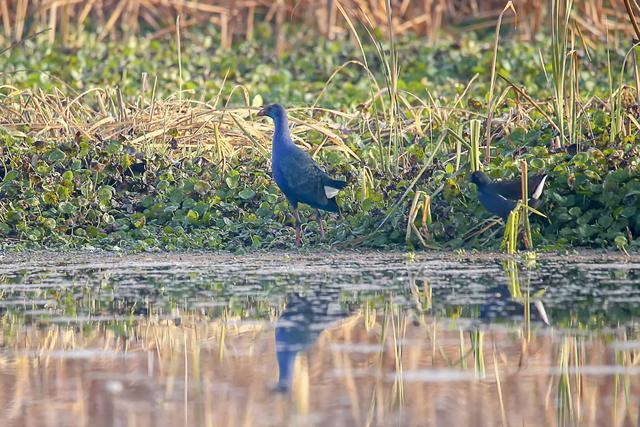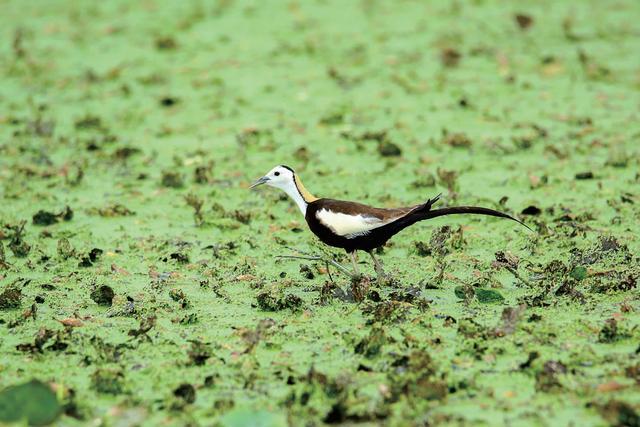He photographs 100 species of wild birds
Editor's note: To take good pictures of wild birds, Li Jiming has been on the go, covering over 1,000 kilometers in a few days or staying in the marsh for days. Owing to his zest and persistence, Li has photographed around 100 species of wild birds. Besides photographing birds, he also devoted himself to bird protection. Li has reported quite a few incidents that are harmful to the wild birds. At leisure, he would chat with Jining folks on how to care for birds.

Two Baer's pochards are spotted in the Dianchi lake area, central Yunnan province. (Photo/Li Jiming)
He photographs 100 species of wild birds
Last month, Li Jiming was rushing about and covered over 1,000 kilometers, just for photographing the Hodgson's frogmouth and the large-tailed nightjar. “I’m lucky to have photographed the rare birds,” said Li.
A native of Kunming’s Jinning district near the southern shore of Lake Dianchi, Li Jiming is a photography enthusiast and member of the Yunnan Wild Birds Association. To capture rare birds, Li has long been on the run. Data show that in the Jining wetland alone, he has photographed nearly 100 bird species.
Growing up near the Dianchi Lake, Li Jiming spent his childhood days in the surrounding rivers, catching fish or shrimps with his play mates. And he regards Dianchi as the mother lake. As an ecological photographer, Li has used the lens for recording the lake’s eco-environment. According to those familiar with Li, he is often seen taking pictures near the lake, and his photographic works are based at the Jining wetland.

Li Jiming photographs wild birds in the Jining marshes near Lake Dianchi, central Yunnan. (Photo provided by Li Jiming)
Over the past decade, Li Jiming has captured 100 plus species of wild birds near the southern shore of Dianchi, involving the bar-tailed godwit, the glossy ibis, the purple heron, the western swamphen, the white-browed crake, the ruddy turnstone, the cotton pygmy goose, the little ringed plover, the blue-tailed bee-eater and others. He also photographed the rare birds of the small dabbling duck, the greylag goose, the water rail and more. All had been missing in the lake area for decades.
Among the wild birds photographed by Li, many belong to the endangered species. The Baer's pochard, first shot by Li in the lake area, is dubbed as a “panda” bird, and it is listed as a critically endangered species by the International Union for Conservation of Nature. “The recent years has seen Dianchi become increasingly beautiful. With the lakeside ecology improved, countless migrant birds have chosen to stop in the area for rest, replenishment or wintering.
Having been on the trail for over one month, Li Jiming photographed the black-winged stilt in June 2016. Data showed the rare bird had not been recorded in Yunnan, and he turned out to be the first one to see the species breeding in the province. In September that year, Li captured a large group of around 1,000 grey headed lapwings that appeared in the Jining wetland area. “Either foraging, flying low, hovering or circling in the sky, they decorated the lakeside green land and the blue dome.” Recalling the moving scene, Li still looked excited at his discovery.

A western swamphen is seen in the Jining marshes near Lake Dianchi, central Yunnan province. (Photo/Li Jiming)
At leisure, Li enjoys chatting with local folks on how to protect water fowls in the lake basin. While photographing in the lakeside marshes, he noticed and reported quite a few incidents that are harmful to the wild birds. He personally tore down tens of trammel nets for bird hunting, and rescued dozens of rare water fowls.
“The bird is not only a guardian of agriculture, but also an indispensible eco-resource. Caring for birds should be an idea for man-nature development in harmony; extinction of any bird will be harmful to humans and their future generations.” Li Jiming called on the public to report to local forest police at the sight of weak or injured birds; he also reminded his peer photographers and bird watchers of wearing a camouflage jacket, avoiding shiny clothes. Photography and bird watching need to be carried out with the minimum disturbance in their living and foraging; humans are not supposed to approach the birds with alert, said Li. "For birds in the breeding season, we need to keep a due distance from their nests. Never change the nest surroundings."

A pheasant-tailed jacana is captured in the Jining marshes near Lake Dianchi, central Yunnan. (Photo/Li Jiming)
As member of the Yunnan Wild Birds Association, Li Jiming has witnessed the eco-improvement of Lake Dianchi, while photographing the wild birds. “These years has seen local authorities invest a lot in wetland conservation, building up eco-shields for the Dianchi lake and sound habitats for the wild birds.” Along with the wetland restoration, the improved eco-environment in Jining has invited in an increasing number of birds. The water in Dianchi is now clearer, and the surrounding areas are more livable. Li Jiming said the Dongdahe wetland park in Jining has grown to be a wintering habitat for migrant birds. Some even settled down and bred at the park.
Writing by Times reporters; Trans-editing by Wang Shixue